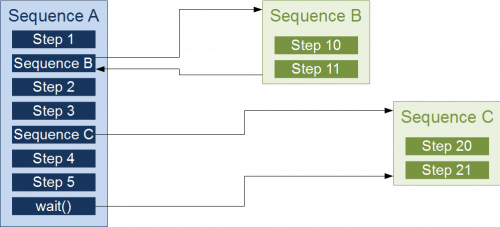Sequence
A sequence is a well defined course of steps. These steps run in a strictly sequential order until the sequence has finished or some condition causes the sequence to stop. In such a case the sequence could be repeated or another sequence could be started.
Blocking and Nonblocking Sequences
A main feature of a sequence is whether it blocks the flow of control during running through its steps or whether the steps run in parallel to the main flow of control.
Sequence A runs. That is, all its steps run consecutively. After step 1 is done the sequence B is called. As B is blocking its two steps run while A is being blocked. Only after B finishes does the control return back to A where step 2 and step 3 are then executed. After this sequence C is called. As C is nonblocking its two steps run in parallel to the remaining steps of sequence A. A must wait for C to finish by calling wait().
A nonblocking sequence will run in its own thread of execution while a blocking sequence always runs in the same thread as the calling sequence.
 The main sequence must always be defined as nonblocking. Otherwise, the flow of control would not return to the main program after calling start() of the main sequence.
The main sequence must always be defined as nonblocking. Otherwise, the flow of control would not return to the main program after calling start() of the main sequence.
Sequence and Step
Every step is itself basically a sequence. However, a step is always blocking. All the other features such as preconditions and exit conditions as well as monitors are identical, see below. A user has to define her own sequences or steps as described in Define your own Sequence or Step.
Process Flow of a Sequence or Step
Each sequence or step runs as follows
- Every sequence starts by checking the preconditions for this sequence to be met. If the test fails the sequence will immediately stop.
- The main work of the sequence is done in the function action(). Such a function can include any amount of work. However, this function should not block (do not use sleep, do not wait for some condition, do not wait for user input). This point is highly important, because a blocking action-function does not allow for checking exit conditions and monitors, see Define Exit Conditions.
- The sequence than repetively checks for its exit condition to become true. As long as this is not the case, the sequence or step stays in this loop.
- In parallel to checking the exit condition the monitors of each sequence are also checked. For monitors see Conditions and Monitors. As soon as a monitor fires the sequence or step will terminate.
Simple Example
class Move : public Step { public: Move(std::string name, Sequence* caller, Robot& r) : Step(name, this) { } int operator() (double x, double y) {xPos = x; yPos = y; return start();} int action() { robot.setValue(xPos, yPos); return 0; } bool checkExitCondition() { return (robot.getPosX() > xPos && robot.getPosY() > yPos); } private: double xPos, yPos; }; class MoveSequence : public Sequence { public: MoveSequence(std::string name, Sequencer& seq) : Sequence(name, seq), moveXY("step", this) { } int action() { robot.moveXY(10, 10) robot.moveXY(15, 25); robot.moveXY(22, 35); return 0; } private: Move moveXY; };
The sequence MoveSequence comprises three steps moveXY. Each of them moves a hypothetical robot a predefined robot in x,y direction.
Waiting for Sequences to Finish
Usually at some stage in your program you have to wait for a given sequence to finish until the program should continue. Let's assume that a main sequence starts another nonblocking sequence and at some stage wants to wait until this second sequence has finished. For this a sequence can be waited for with wait().
This method returns as soon as all the steps defined in the sequence have completed running. In order to get the return value of the sequence you can use getResult().


